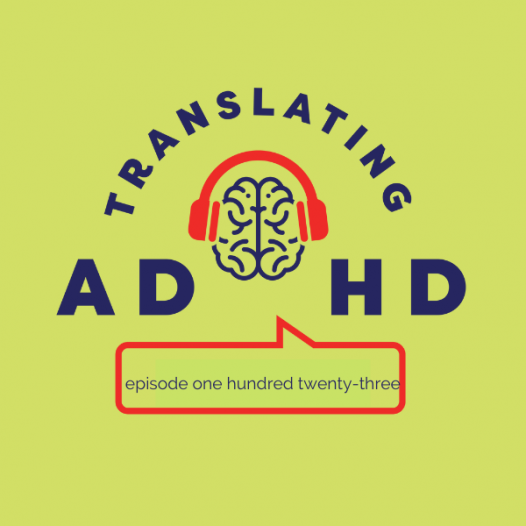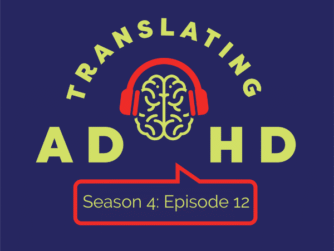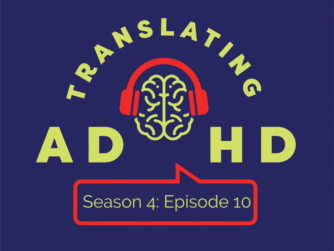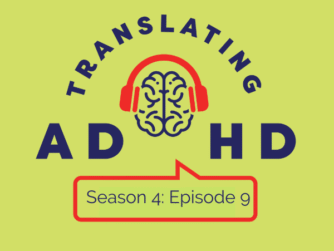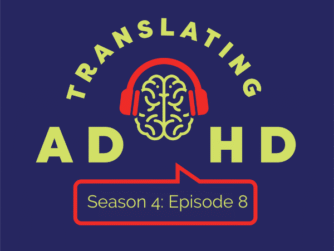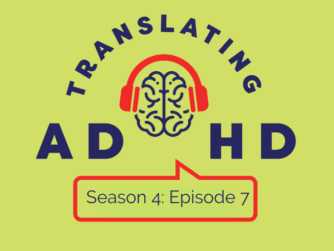Cam and Shelly go Big-Brain this week tinkering with the very structural elements of their Mt. Rainier Model (episodes 60-63). They introduce a concept not often considered in conventional ADHD conversations – language that often includes terms like interest, regulation, management and attention. The term introduced this week is valuation, and valuation matters because it lives between attention and motivation. Valuation is simply the amount of value we place on something. Cam argues that those of us with ADHD struggle to see the value of something because of the disruptive nature of ADHD. You can’t value what you can’t access. You can’t access what you can’t sense. ADHD impacts our ability to both sense and access concepts like time and emotion.
Cam shares client examples that turn conventional wisdom on its head. Stories of clients challenging conventional takes on concepts like time and emotion. These clients are not just settling for management or regulation. These stories are forcing Cam to rethink the Rainier Cause and Effect model.
Finally, Cam and Shelly share a new process similar to Pause, Disrupt and Pivot. The new process is Sense, Access, Value. Cam and Shelly are just at the beginning with exploring this concept of valuation.
Episode links + resources:
For more of the Translating ADHD podcast:
- Episode Transcripts: visit TranslatingADHD.com and click on the episode
- Follow us on Twitter: @TranslatingADHD
- Visit the Website: TranslatingADHD.com
Episode Transcript:
Shelly: Hi, I’m Shelly.
Cam: And I’m Cam.
Shelly: And this is Translating ADHD. Quick note on our group coaching offerings. We’ve been talking the last several episodes about our resilience offering. We were trying out a morning time slot to accommodate time zones that don’t necessarily work for late in the evening, Eastern time. However, we weren’t getting a lot of interest, or really any interest at all, in that particular time zone. So we are still offering resilience as the next course, but it will now be back at our regular time, which is Wednesday evenings at 8:30 PM Eastern. And that course will begin June 22nd. For all of the information, including the course content pricing, and how to apply, visit the website, translatingadhd.com and click on group coaching.
So Cam, we came in a little cold today because I dropped the ball yesterday and had nothing. And you’ve got something for us today. And I’m only a little bit understanding what it is. So I’m just going to turn it over to you rather than try and say what it is and let you do that part this week.
Cam: Yeah, but this is the trust that we have. Trusting in each other, trusting the process that we’ve developed. And I didn’t have it either yesterday. And you told me as much. You said it was like, Cam, you don’t have it. Let’s get together tomorrow. What time are you available?
Shelly: Right. Because as we’ve talked about before on the show, you have a process of slow baking. And so when I arrived without a topic, you had a topic, but it wasn’t yet baked enough. So I’m hoping the loaf is a little browner now, and I’m excited to hear what you’ve got.
Cam: It is. The loaf’s a little browner. It’s a big topic that is still baking, but that’s kind of the cool thing is, part of the theme of today’s letting stuff bake and continuing to work on stuff, right? So you sent me off as like, you don’t have it, you know, work on it and come back in your supportive, loving way, Shelly. And so I went for a bike ride, fixed my tire, got my bike going, get my ankles back out in the woods.
I was like, oh, I’m getting it. And you know, we’re doing this as foundational stuff. It’s like, people were looking at Mount Rainier, I’m looking at Mount Rainier, and I’m seeing there might have to be some modifications to Mount Rainier, right. Yeah, I’m just going to, I know there are people out there like, wait a second. Wait, wait, wait. I’m starting to understand Mount Rainier, you know, like, okay. You want to put a lunch counter there in the middle of the mountain? Fine, Cam.
Shelly: Okay, I’m there. I just stink to leave three reactions to your topic about it’s been a among our audience, the one you just named, the people who love the metaphor as it is, and don’t want you to mess with it. And the people who don’t think in metaphor, who are like, oh,
Cam: Right. Absolutely. Yeah. So have your reaction. All right, everyone but there’s a flaw with Mount Rainier. And the flaw is this – there’s amazing stuff that happens above the lunch counter because I’m witnessing it right now with some of my clients. And last night I had a group of long-time clients who have moved into a group and we’re looking at leadership and emotion, and I’m looking at these people and they’re doing some crazy stuff, Shelly. And they’re doing more than just managing time or regulating emotion. And these people are doing some advanced stuff above the lunch counter. So I’m like thinking about lunch counter, yeah, it’s icy. It’s up in the clouds and it’s cold. What’s so exciting about that. And oh yeah, there’s either a clar Rubik’s cube at the top of that. I want to say that with destination thinking, we feel like there’s a destination we get to with our work with ADHD, right? Or are we done yet? Am I done? Can I go back to doing what I do and just be done with this thing yesterday? We talked about this with our project X class around looking at project X’s like destination thinking way or journey thinking way, right? You’ll never have an open window in your calendar where you can just work on project X. We’ve gotta be able to find ways to put it into our busy lives.
Shelly: Really interesting, Cam. I see this show up at another place with my clients. And in fact, the client that I met with just before recording, we had that session today and it’s a normal and predictable part of the code process where this client now has a lot of awareness. So they’re seeing the unwanted behavior.
They’re seeing the stories that they’re telling themselves in the moment that are driving emotion. They’re seeing the one down, but they’re not yet able to have a different experience there. And so they arrive and it’s this just, ah, frustration of I understand it now. Why is it not different? Why is it not different yet? And I would say a vast majority of my clients are going to have that session at some point where they arrive and it’s like ADHD, just one this week. Have we even made any progress? Have I even done anything so I can go both ways in terms of, is there a place where I’m finally done with this work, but also on the other side, I’m doing all this work and I’m not seeing results. The results aren’t coming fast enough.
Cam: Right. And this phenomenon happens when our level of awareness is building. And yet our traction on creating change is not keeping up with the awareness. So we have this feeling that we’re, again, the distance is moving, it’s the sensation of going backward when in fact what’s happening is you’re building this really important library of information.
Last week, we talked about self-knowledge – the power of awareness, but yeah, it’s really nice to be able to start to match change behaviors, right practices with our new awarenesses. And so today I want to talk about a term that I’ve been playing around with, and that is valuation.
And so valuation you can think about, oh, it’s like a money term. Fiduciary or market term valuation. I want to look at it. And just the terms of how much is something worth. And I want to bring it to two areas that are really significant for our clients, and in the realm of lunch counter stuff, right. Lunch counter stuff is those symptoms that are presented. This is your dilemma, and this is what you do, right? It’s that prescriptive approach at the lunch counter, we’d get our little dish and we walk away.
Shelly: Write it down, set a timer, get a planner.
Cam: Right. You have a dilemma with emotional regulation. What you need to do is learn how to regulate, watch out for flooding and triggers time. You have an issue with time and you need to manage time and how to manage time better. I’ve never been satisfied, Shelly, with the terms regulation and management. They’ve never been satisfying for me.
And again, that seminal moment back in 2004, where I had to learn what was getting in the way. It wasn’t about just managing or just regulating. I had to understand and appreciate the value of emotion, the value of time. Right? So this concept of time blindness is it’s relevant, it makes sense, but take it with a grain of salt.
Not that we can’t see time. It’s that we don’t know how to value time, and I just have a statement here I’ve been playing around with how do you value something you can’t access? And how do you access something? You can’t see that emotion and time are both these elements that are difficult for us to see and access on a regular basis. And if you have an inconsistent performance history with time and emotion and O memory and motivation and attention and all these elements that are in the DSM, how can you create real value? Know the value of it. Why am I talking about value? Because I’m talking really ultimately about motivation. What motivates us?
Shelly: Cam, I just want to jump in here and say, for example purposes, you’re talking about time, and you’re talking about emotion, but there’s also the ways in which those two things interplay with one another in an ADHD brain. I was talking to a client earlier today about that very thing where there’s a story that he’s not as good as a coworker who has a different personality type. And so he has to hurry up and get stuff done before that guy takes it from him, and what does that cause him to do? It causes him to do the exact opposite of what he knows works. What he knows works is collaborating to break down a big task. Pulling in a coworker helped me wrap my brain around this, helped me figure out what’s next, helped me see the individual trees in this huge forest. But when that urgency driven by that story kicks in, he does the exact opposite of that, which in fact, causes him to lose time when the whole story is around “this is urgent.” You have to get it done now.
And it’s just so interesting to me because again, this is why prescriptive solutions are based on taking pieces of manifestation individually don’t work because right there is both an issue of time and my client’s relationship to time and an issue of emotion. And the fact that while the story is not real, the emotion and the urgency and the anxiety that follow the story are very real.
Cam: Right. I think part of my focus here is that there’s a drum beat. That is happening right now, just around the lunch counter. The Oracle is speaking and the Oracle’s talking about DESR, is deficient emotional self-regulation right. It’s a term that Russell Barkley is bringing forth. And so say that bit in jest. This whole idea of emotional regulation is extremely important. Russell Barkley has a goal of elevating, right? Getting the word out that emotional dysregulation is connected to ADHD, and it’s not in any of the DSM five material in the sense of the diagnosis, assessment and evaluation.
So this is really important, but often what can happen is that drumbeat can be a little too intense that it’s like, again, this is who you are. This is what your experiences. And last night I’m sitting there and I’m with six guys with ADHD, and they weren’t just regular. They were doing something else. One guy was talking and Shelly, I was thinking about you cause one guy was talking about my propensity to avoid, hesitate, to not activate for task is melting away, Cam. And I’m like, what’s that about? And he started his sharing. He was like, you know what I got to get back to. And he sent me an email later.
He’s like you know what, I know what it is. There’s a big change in my life. He changed jobs and he got into a job that aligned more with his sense of purpose. All right, this is up your alley, the sense of purpose and that a context that’s working for him. He’s in alignment. The sense of what he’s doing in the world aligns with who he is at his best. So there’s that interest-based nervous system that is being activated, and he’s creating value around his tasks, but also there’s an emotional belonging and purpose that’s emotion. He’s in the right arena, and he’s making a difference. And so his value around this is increasing.
Here’s the interesting thing I’m going to bring back. One of my clients from long, long ago had this experience that still stays with me today. And we’re talking about time and his perception of time. And one day we’re just talking. He’s like trying to figure out he’s principal in a group and he’s got a team and he has to do his own work. But he’s got meetings. It’s like, how do I get my work done when I have all these other demands going on? We’re just talking, and we’re doing our coaching and he just said, there’s a pause. And I’m like what’s going on over there. I’m looking at my calendar and I’m starting to see white space. In his calendar and it’s like, I have margins their margins and this sort of, different way of looking at time. Now, I can’t tell you what we actually did there. I will say there was keen observer. There was coaching, there was curiosity. And there was being with this experience of okay, time, if we can turn it from this dilemma into something that is more of a resource. And that’s the thing that I’m seeing, Shelly, is this sort of conversion, this valuation around these things that are typically really difficult for us to understand, but it starts with curiosity and that there’s something for us above the lunch counter that’s more enticing than steep, icy slopes and clouds.
And right then there’s some kind of amusement park up there that these people are finding and this new appreciation of time. It’s this new appreciation of emotion. It’s really, really exciting, but it has something to do with this seeing it, appreciate it and accessing it in a different way. It’s an accessibility issue.
Shelly: So, Cam, I freaking love this and it’s so funny how
Cam: Right. Like what a 24 hours, it was like, boom.
Shelly: Well, it’s so funny to me, how you and I can sometimes be pulling on what seems like different threads, but actually turn out to be different parts of the same threads. So I know what we’re going to talk about next week, but let’s go back to what we’re talking about this week because I love this term of valuation, but there’s also this element again. These things interconnect and interplay with each other, and not just the ADHD things of time and emotion, but also the who is this person? What matters to them? What gives them meaning and purpose and things like modality preferences, figuring out how to understand time in a way that works for me in a modality sense, in an emotional sense. in a way that I can conceptualize it. I was talking to a client this morning about the episode we did on metaphor because she, like you, sees images in her brain. And what we were coaching about is this practice of writing to make sense of questions and how we got to this coaching topic. And this was such great awareness on this client’s part, was a couple of the questions that she answered in the previous coaching session upon reflection. She didn’t like her answers. She said sometimes when I’m verbalizing, I’m trying to get to the answer, but when I’m writing, I’m more in curiosity. Writing helps me translate those images to something that I can make sense of in a way that I can make sense of it. Just like metaphor helps you translate verbal articulation. I was telling you about my new metaphor, where for me, I feel like I’ve got the pieces to a hundred different puzzles in my brain sometimes, and I kind of have to spit out all of those different pieces in order to see which ones even go to the puzzle that I’m working on. And what is the puzzle? What is the picture? What is the image? What is the conclusion?
And you could take those same differences and apply them to time, apply them to emotion. Each one of our understanding and relationship is different with those things, but there is something incredibly powerful and real about watching someone step into that for themselves. It’s a new place, and I love that you made it an amusement park because it is a lighter place. I tell my clients when we start coaching, here’s where I want you to be by the time that we stop working together.
And that doesn’t mean we have to stop working together here, but here’s my one goal in our work together is I want you to be in a new place with your ADHD. One in which success and struggle can go hand in hand one in way. You’re not just managing there’s that word again, your challenges, but you’re leaning into your strengths and you see your unique value. And when a client gets to that place, it’s magic and the coolest part of it all is it’s not my magic. Cam or your magic. It’s their magic. We’re a facilitator. We’re there to help them figure out how to draw it out, how to translate it, how to make time, to make those emotional elements make sense for their brain.
How does it see that? It’s not just time or it’s not just emotion or it’s not just organization or it’s not just any one thing, it’s all of the things and the way that it interplays for that client and the way that they make meaning of and understand it is all part of the picture. And when they’re able to do that and step into that new place, it’s something. again, I tell every one of my clients this, when they get there, nobody can take that from you. And that doesn’t mean that ADHD struggle is now gone. Cam and I talk a lot on this podcast about how we still struggle, but it does mean that your relationship to that struggle becomes very different.
Cam: I’m going to take a breath and again, sort of like listeners might be like, whoa, whoa, whoa. So I want to anchor this into something that I think might be on the level of pause, disrupt, pivot around this whole, like, challenging the norms, challenging when someone says this is your experience, to take that and then be curious and move forward with that.
Shelly: I just got to interject and say, I’m sitting here with bated breath because I knew about pause, disrupt, pivot, like a minute before we put it out on the show, but this is…I can’t wait to hear it.
Cam: And by the way, either amusement park or it might be cloud city before the empire arrives. Like that looked like a hell of a place, like a fun place before Darth Vader shows up. Right. Lando. I mean really D what the hell? Sorry, I’m just toying with the metaphor people out there, the metaphor purist of like wait, you can’t put cloud city on top of Mount Rainier.
Shelly: But Cam, what I’m appreciating about this is even there, your facetiousness. There’s another demonstration of you making meaning in the way that works for your brain. You have to play with the metaphor a little bit to get it right for you. And I’ve witnessed that in action many times. So not laughing at you at all, laughing with you, both appreciating your silliness, but also appreciate it.
There is that thing happening in action right there. That was a moment of Cam stepping back and saying, I don’t know that I’ve fully made this meeting yet. It’s still baking.
Cam: Baking. Right. We’re still baking the loaf. It’s a little browner, it’s getting there. Okay, so a little bit of a lead I’ve got these business owner clients who are like, I’m really tired of like, do I have to deal with drama in the office, Cam, right. And managing people and their drama and their dilemmas. Like, I didn’t sign up for that. I signed up to run a business, but they’re in the business of getting people, whether it’s clients or teams, you’re going to have emotion in the room. And if you can kind of come to see that emotion, isn’t this thing that you just have to deal with and be in this reactive state versus getting on the balls of your feet, more proactive and like, okay, what is it?
Can I learn about this or create value around this? Create some interest in understanding and appreciation with ADHD. Shelly and I always talk about, it’s often an orienting dilemma to orient to, and this is what is the opportunity here, as I said, it’s hard to value something. If you can’t access it, it’s hard to access something if you don’t see it. And so this is the process, and the practice for listeners is that don’t dismiss time as this thing you don’t understand, or you’ll never, you know, get ahead of..you can’t get ahead of time by the way. Right. But you also don’t have to be behind time all the time.. is that to be curious about your relationship with time and to start with seeing. To see it like my clients saw it in a different way.
Shelly: I just want to jump in. The only thing I want to challenge about this is the word. I like the word sense because as we just discussed, time can be about emotion. Time can be about needing to visualize differently, to have some margins, to have some white space. Each of our clients senses time differently, but the thread that binds them all together is they don’t sense time in the way neurotypicals do.
Cam: Love it. We’re in the workshop right now and also, again, I’m talking about emotion too, right? So it’s, you don’t necessarily see a motion, but right, it’s a feeling and secondly, accessibility is how to access. We sense it, but we’re not sure what to do with it. We don’t have that ability to activate and access, just like it’s hard for us to access those important, not urgent tasks.
So this sensing and accessing the practice piece to get in, you’re not going to know the value you can’t get to the value and around value is again, motivation. This is what we’re focused on here is what is motivating And so you can’t get to motivation unless you have that sense of value, how can be a value to you and others and your team, it brings us back to first sensing to sense it and be with it and be curious about it, how it. shows up, what’s confusing about it. What makes it like a time blindness experience? Right. The distortions. I love that you brought in again the how emotion and time interweave with each other. And yes, it’s this integrating aspect. It is, it’s very lots going on with the who the why, what we’re doing. But today it’s looking at the. Kind of typical challenge areas and to challenge the norm, they’re like, oh, well I have ADHD. And you know, I just, I have a problem with emotional regulation and I have a problem with time. Do you see how definitive that is? Or kind of like, boom, it is what it is. It’s the way it is to look past that lunch counter and pushed through To bring curiosity and creativity and just bring that keen observer to time and emotion to explore that. How might it be different then you can get to that valuation aspect and only there can we truly get into something that’s motivating I want to, share, uh, an analogy, one that I’ve been using with my groups that I’ve been working with around emotion. And again, it’s like beyond regulation. So a wheelchair ramp, the angle matters, right? You think about, you know, a wheelchair ramp that’s too steep or too shallow. And often what happens is our accessibility to something like emotion is too steep, too intense or not steep enough. Right. There are two arguments in the camp of ADHD with emotional regulation. They’re too intense. They’re too sensitive or. They’re not emotionally available. And so starting to look at what is your angle that helps you kind of, again, move through an emotional experience where it’s not too intense or not enough, right? That’s that accessibility in the middle. But to start with that sensing and curiosity, And once you kind of, sort of play around with that, then you can start to discover the value and seeing these things more as a resource than as a barrier.
Shelly: The only thing I’ll add to that, Cam, is it’s not one angle for every emotional situation or every time situation.
Cam: Absolutely.
Shelly: This is back to everything interweaves and the work that Cam and I primarily do is to help people sense the things they can’t sense so that they can make meaning and build awareness about what their experience actually is. Also the absolute, most fun part of our job. It is really cool to see the intense variety in articulations of experience and the work that we do. It’s so fun. Also got to say, favorite part of doing the show. And it’s been a minute since we’ve had one of these is when one of us brings something cold and says, let’s go. And then you and I spend half an hour blowing each other’s minds, so a lot of fun today. With that being said, we are out of time, although I know that there is more here for us to pull on.
So If you like what we’re doing here on the show, three big ways you can help us out. You already know them. We’re going to say them again. Number one, leave a review wherever you listen, please, please, please. If you listen and you are capable of doing so, please take a moment to stop and leave a review for us. Number two, share us on social, share us and neurodivergent groups at work, share us anywhere that we might be a resource to others. I know that we have a lot of coaches and therapists sharing us as a resource with their clients and patients. So thank you to everyone sharing us, particularly to those professionals that trust us enough to make us a part of your client experience. That’s always something that is so awesome and humbling to hear.
Cam: Yeah, blows me away.
Shelly: And finally, you can become a Patron for $5 a month. You are helping Cam and I cover all of the costs of running the show, including our incredible support team of editor and assistant, and you gain access to our discord community, where our listeners are working together to do their own understand, own and translate work. To do that, visit the website translatingadhd.com and click on the Patreon link in the upper right-hand corner. So until next week, I’m Shelly.
Cam: And I’m Cam
Shelly: And this was the Translating ADHD podcast. Thanks for listening.

